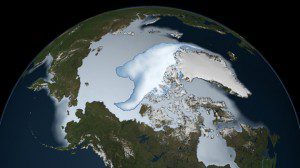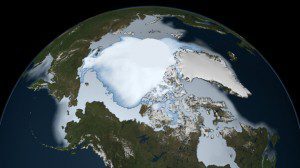
Multiyear ice is shown in bright white, while average sea ice cover is shown in light blue to milky white in this 1980 satellite image data. The data show the ice cover for the period of Nov. 1 through Jan. 31.
A new study by NASA scientist Joey Comiso has found that Arctic multiyear ice “extent,” which includes all areas where at least 15 percent of the ocean surface is covered by multiyear ice, has been vanishing at a rate of “15.1 percent per decade.

Multiyear ice is shown in bright white, while average sea ice cover is shown in light blue to milky white in this 2012 satellite image data. The data show the ice cover for the period of Nov. 1 through Jan. 31.
Over the same period, the “area” covered by multiyear ice, which discards open water among ice floes and focuses exclusively on regions that are completely covered, has been shrinking by “17.2 percent per decade. The findings were published in February 2012 in the Journal of Climate.
The accompanying images show sea ice coverage in 1980 and 2012, as observed by passive microwave sensors on NASA's Nimbus-7 satellite and the Special Sensor Microwave Imager/Sounder (SSMIS) from the Defense Meteorological Satellite Program (DMSP). Multiyear ice is shown in bright white, while average sea ice cover is shown in light blue to milky white. The data show the ice cover for the period of Nov. 1 through Jan. 31 in their respective years.
The thickest “multiyear” ice survives through two or more summers, while young, seasonal ice forms over a winter and typically melts just as quickly as it formed. Scientists also describe a third category: “perennial” ice is all ice cover that has survived at least one summer. All multiyear ice is perennial ice, but not all perennial ice is multiyear ice.
Comiso found that perennial ice extent has been shrinking at a rate of “12.2 percent per decade, while its area is declining at a rate of “13.5 percent per decade. These numbers indicate that multiyear ice is declining faster than the perennial ice that surrounds it.
As perennial ice has retreated over the past three decades, it has opened new areas of the Arctic Ocean that could then be covered by seasonal ice. A larger volume of seasonal ice meant that a larger portion of it could make it through the summer to form second-year ice. This is likely the reason why the perennial ice cover, which includes second-year ice, is not declining as rapidly as multiyear ice cover, according to Comiso.
“The Arctic sea ice cover is getting thinner because it's rapidly losing its thick component,” Comiso said. “At the same time, the surface temperature in the Arctic is going up, which results in a shorter ice-forming season. It would take a persistent cold spell for multiyear sea ice to grow thick enough again to be able to survive the summer melt season and reverse the trend.”
Source: NASA

